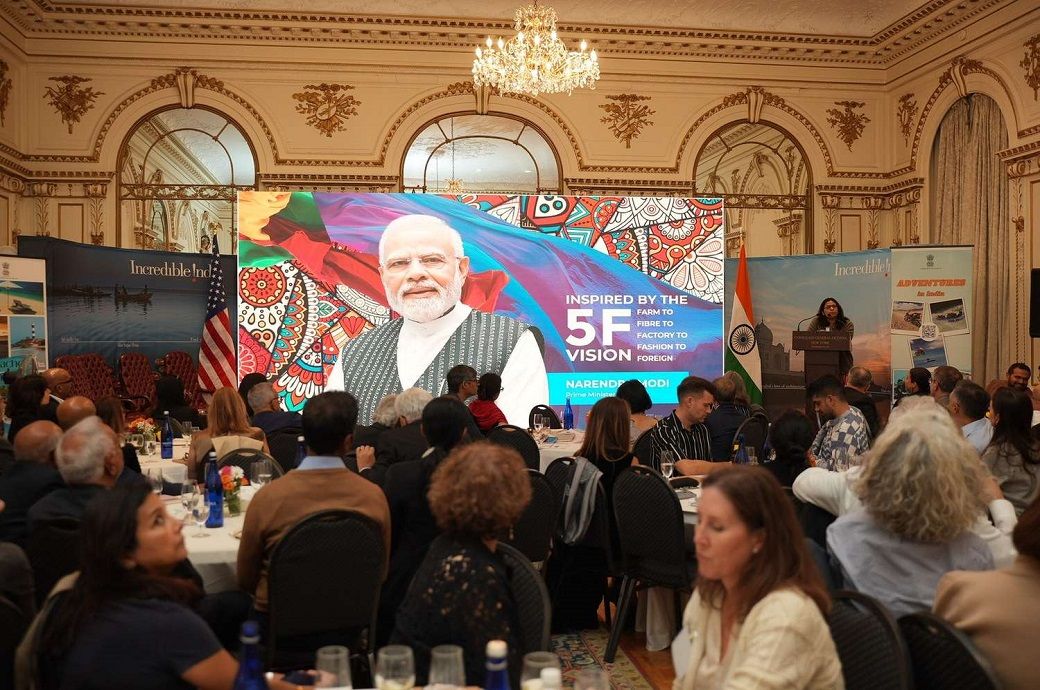
The textile sector accounts for 2.3 per cent of India’s GDP, directly employing over 45 million individuals and indirectly supporting another 55 million. Its diverse product range, from handcrafted khadi and silk to advanced technical textiles, underscores its pivotal role in the economy and global markets. Aligned with the 5F vision—Farm, Fibre, Fabric, Fashion, and Foreign Exports—the industry integrates traditional heritage with modern production. With a diverse range of products, including traditional handloom, handicrafts, wool, silk, and organised textile industry segments, the Indian textile industry thrives across its entire value chain, from fibre to apparel. The organised sector is characterised by mass production, spinning, weaving, processing, and apparel manufacturing, distinguishing itself as highly segmented and capital-intensive.
India’s textile sector, poised to hit $350 billion by 2030, will showcase its innovation, sustainability, and global impact at Bharat Tex 2025 from 12-17 February.
The event features 5,000+ exhibitors, 20,000+ exhibits, and 70 sessions on trends like eco-friendly practices, technical textiles, and ethical sourcing.
Backed by global brands and agencies, it highlights India’s 5F vision.
Indian textile manufacturers attract global brands with competitive pricing and diverse offerings. To meet evolving fashion trends and global demands, the industry is enhancing its design capabilities and expanding into high-value technical textiles for healthcare, automotive, and agriculture sectors. A notable pivot involves reducing reliance on cotton by boosting synthetic fibre production, a strategy supported by the National Technical Textiles Mission. While cotton remains the dominant fibre, accounting for nearly three-quarters of the country’s total fibre consumption, the industry has faced stiff competition from global players like China, Bangladesh, Pakistan, and Vietnam.
The government is driving growth through initiatives promoting renewable energy, ethical practices, and waste management. Skill development in rural areas and adoption of technologies such as CAD and automation are transforming the workforce. Bharat Tex 2025 will occupy 2.2 million square feet of exhibition space, accommodating over 5,000 exhibitors and presenting more than 20,000 exhibits. Anticipated to attract over 6,000 international buyers and 12,000 domestic business visitors from 110 countries, Bharat Tex 2025 has gained the support of global and domestic brands such as Aditya Birla, Reliance Industries, Trident Group, and Welspun, alongside participation from companies like Mafatlal Industries, EM Crafts, and Supreme Nonwoven Industries Private.
Bharat Tex 2025 is backed by the Ministry of Textiles and organised collaboratively with 11 Export Promotion Councils. Sustainability remains at the forefront, with global entities such as the Better Cotton Initiative, UNEP, and Laudes Foundation joining corporations like Aditya Birla Group and Arvind to share expertise on scalable solutions. Attendees can expect over 70 knowledge sessions led by renowned partners, including KPMG, Gherzi, and NIFT, offering critical insights into trade dynamics, investment opportunities, and technological advancements. The event will not only foster international collaborations and trade but also feature vibrant cultural displays that position India’s rich textile heritage and innovative future as a global benchmark.
The exhibition will feature specialised pavilions that address industry trends, such as the Sustainability Pavilion, showcasing eco-conscious practices, and the Start-Up Innovation Pavilion, highlighting emerging enterprise solutions. The Craft Museum – Indi Bhaat will honour India’s traditional arts and crafts heritage. Interactive Fabric Zones will allow attendees to explore diverse textiles and sustainable fabrics, offering hands-on inspiration for innovations in the textile industry. Upcycled and eco-friendly textile installations will add artistic flair to the expo, while spectacular cultural performances and fashion shows will celebrate India’s cultural legacy on a global stage.
The event will delve into key themes, including sustainable innovations like water-efficient dyeing and organic cotton farming, circular economy practices such as recycling and closed-loop manufacturing, and ethical sourcing promoting fair wages and safe working conditions. Events like the International Silk Conference, Better Cotton Annual Meeting, and Innovation Hackathon will provide opportunities for collaboration and knowledge sharing. Master craftsmen will also display inherited artistry alongside trend forecasts, product launches, and master classes to highlight India’s deep heritage and forward-thinking industry approach.
This transformative event has garnered support from UN agencies such as UNEP, UNDP, UNESCO, and UNIDO, along with government bodies like Niti Aayog, cementing Bharat Tex 2025’s status as a pivotal platform for India’s textile industry on the global stage. Bharat Tex 2025 is poised to lead India’s textile sector into a new era, reinforcing its position as a pioneer in sustainable textile manufacturing while strengthening its global standing across the entire value chain.
Fibre2Fashion News Desk (HU)





